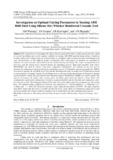| dc.contributor.author | Wathigo, James Mwangi | |
| dc.contributor.author | Keraita, J.N. | |
| dc.contributor.author | Byiringiro, Jean B. | |
| dc.contributor.author | Muguthu, J.N. | |
| dc.date.accessioned | 2017-09-11T13:25:04Z | |
| dc.date.available | 2017-09-11T13:25:04Z | |
| dc.date.issued | 2017-08 | |
| dc.identifier.citation | IOSR Journal of Mechanical and Civil Engineering, Volume 14, Issue 4 Ver. II (Jul. – Aug. 2017), PP 80-88 | en_US |
| dc.identifier.issn | 2320-334X | |
| dc.identifier.uri | http://hdl.handle.net/123456789/2832 | |
| dc.identifier.uri | http://repository.dkut.ac.ke:8080/xmlui/handle/123456789/610 | |
| dc.description.abstract | This research was to investigate the effects of process parameter that is cutting speed, feed rate, depth of cut and machining time on the response variables in turning AISI 8660 material using whisker reinforced ceramic cutting tool. Cutting tools are weak and there is continuous effort to improving their performance and wear characteristics so that different grades of materials with varied degree of hardness are machined at minimal cost and economies of production can be realized during machining. This study investigated the rate tool wear and the cutting forces involved during the machining process. High speed machine lathe (Type: MORESEKI) was used on which a three force component dynamometer was mounted on the tool post to measure the cutting forces involved during the machining process. A Toolmakers microscope (model no: 80091) was used to measure the tool flank wear (VB) and the maximum tool wear recorded was 0.27mm and occurred at approximately 3.0 minutes during the machining process. Design of Experiment based on Taguchi technique was developed to obtain the experimental data. Response Surface Methodology (RSM) was used to analyze the data by developing 3D surface plots, contour plots and Main effects plots for Signal to Noise Ratio. The residuals plots analysis for cutting force revealed a normal probability plot for the data used indicating a close fit to the best of line. The histogram indicated 80% and 10% as the highest and lowest frequency for the cutting force. The optimal cutting conditions for toolwear were obtained at v = 158.28 mm/min, f = 1.116mm/rev, d = 1.38mm, and t = 2min with the process having a high composite desirability at 0.8557. The high composite desirability means that the process variable satisfies the target goals which are minimizing cutting forces and toolwear and that SiC whisker reinforced cutting is the recommended tool when machining this material. | en_US |
| dc.language.iso | en | en_US |
| dc.publisher | IOSR Journals | en_US |
| dc.subject | Cutting force | en_US |
| dc.subject | Machining (hard turning) | en_US |
| dc.subject | Response Surface Methodology | en_US |
| dc.subject | Taguchi Technique | en_US |
| dc.subject | Tool wear. | en_US |
| dc.title | Investigation on Optimal Cutting Parameters in Turning AISI 8660 Steel Using Silicon (Sic) Whisker Reinforced Ceramic Tool | en_US |
| dc.type | Article | en_US |

